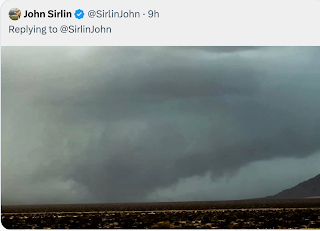The Continuing -- Major -- Issues With Tornado Warnings
As we have discussed many times, the National Weather Service (NWS) has numerous, and growing, issues with its tornado warning program. See just a few of the articles here, here and here. There are many more articles beyond those. These issues resurfaced again Saturday, including the period when the EF-4 tornado approached Winterset, Iowa, (video above). The tornado warning was delayed more than nine minutes and others more than seven minutes.
Shockingly, senior officials at the NWS do not have a sense of urgency to resolve these problems. Complicating matters is the NWS is in-between directors at this time.
The Washington Post investigated and found that a cut cable in Texas (!) caused the communications system to overload. This is common with NWS dissemination systems.
While the time the Des Moines NWS meteorologist pressed "send" at 4:11pm, the Twitter graphic didn't transmit until 4:18.These delays affected every tornado warning issued in Iowa Saturday afternoon. I do not know if NOAA Weather Radio also had these problems but every other dissemination pathway did.
The NWS answers to the National Oceanic and Atmospheric Administration. It's new administrator, like all of the administrators for a half-century before him, has no background in meteorology even though weather is the biggest thing NOAA does. His list of goals for the agency do not include fixing the tornado warning problems.
A well-known television meteorologist reached out to me this morning and said,
TV meteorologists cannot rely on the NWS to pull the trigger for a tornado warning and must do it for ourselves.
Among the problems Saturday: the graphics generator at the NWS office in Des Moines was transmitting Spanish, but not English, warnings for hours. In addition, the text and other version of the tornado warning products had serious delays.
 |
| List of Tornado Warning dissemination delays Saturday in Iowa |
The 4:11pm tornado warning for Winterset (below) was, in some cases, delayed more than nine minutes (see chart above).
Early in the afternoon, when I first observed these issues, I decided to live-tweet tornado warnings as a way of backstopping the NWS. As I was doing so, I watched KCCI-TV's coverage and it appeared to be excellent. I have no doubt these efforts saved lives.
Tragically, we were not entirely successful. The Daily Mail has a story about some of the victims:
Within this family, the grandmother, husband and two of the children were killed. Two others were killed in the Winterset area. A seventh person was killed east of Des Moines. Let me emphasize that I do not know what connection, if any, there was between the warning dissemination problems and the casualties. Even with the delay, there was more than ten minutes between the time the (delayed) warning went out and the tornado arrived in Winterset.
All of this overshadowed a fine performance by NWS meteorologists.
- There was a tornado watch issued 2.5 hours before the tornado struck. It was accurate and the timing worked out very well (if it is issued too early people forget about it).
- Winterset tornado warning: The warning was available about 4:18-4:21. The tornado reached the area where the fatalities occurred at about 4:37pm. Based on social science research, sixteen minutes is near the ideal of 13-15 minutes (counterintuitively, beyond ~15 minutes, fatalities rise).
- As far as I know, the Des Moines NWS office's tornado warning were of excellent meteorological quality.
So, why did seven people die?
The same meteorologist who contacted me this morning volunteered a hypothesis:
Another thing to stress here, Mike, is that the younger generation is not watching local news. How are they staying weather aware?
Again, I have no information indicating what specific issues might have led to the fatalities in Winterset. Some thoughts:
- This is why we urge everyone to have multiple sources of tornado warnings.
- Twenty years ago, everyone knew to turn on the television when the sirens sounded or a strong thunderstorm was moving in. But, that might not be the case today.
- The following is speculation: the family was from Missouri visiting their grandmother in Iowa. If an app was set for a specific location, it would not trigger after traveling from one state to another.
- Another possibility is this EF-4 tornado was just too strong. The photo below is of a basement near Winterset. Anyone sheltering there could have been injured or killed by flying or falling objects.
This Reagan conservative hates to advocate for an enlargement of government, but the United States desperately needs a National Disaster Review Board (NDRB) that is modeled on the highly successful National Transportation Safety Board.
To summarize:
- NWS technology is inadequate to the task. This has been proven many times. It too often fails when needed the most.
- While not a problem Saturday, NWS meteorologists, in some cases, are inadequately trained to issue timely, accurate tornado warnings. The NWS itself has confused the issue by attempting to limit false alarms without solid science to do so.
- Regardless of whether it was an issue Saturday, there is clearly a shift in how the public receives tornado warnings.
- It appears much of the current meteorological infrastructure (NWS communications, apps, etc.) work great when the weather is fair but fail when under stress. This must be fixed and would be the perfect thing for the proposed NDRB to examine and make recommendations.
Undoubtedly, there are more issues than the ones I have written about here. We must urgently fix them before another Joplin occurs where 100+ needlessly lose their lives because of the growing issues with the tornado warning system.
© 2022 Mike Smith Enterprises, LLC








Comments
Post a Comment